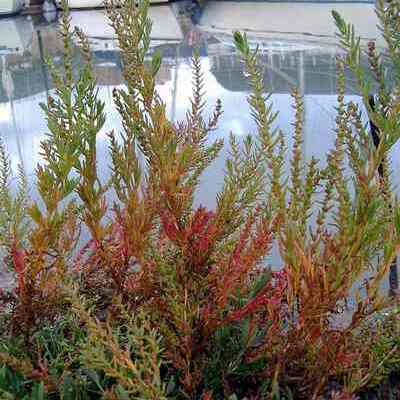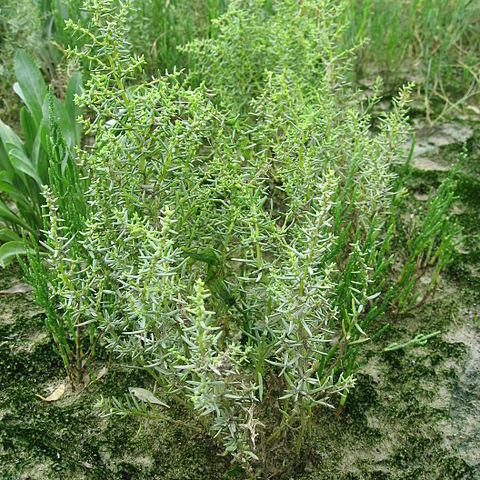Annual or perennial herbs or shrubs, usually glabrous. Leaves usually fleshy, entire, usually alternate, narrow, cylindrical or somewhat flattened. Flowers axillary or sometimes adnate to the subtending leaf, solitary or clustered, subtended by small scarious bracteoles, hermaphrodite or unisexual. Calyx 5-lobed or-partite, sometimes thickened or inflated in fruit, but not winged. Stamens 5, absent or reduced to staminodes in the ♀ flowers. Ovary sessile on a broad base, or partly adnate to the calyx. Stigmas 2–5. Fruits with membranous or sometimes spongily thickened indehiscent pericarp. Seeds “horizontal” or “vertical” (i.e. vertically or laterally compressed); testa normally smooth, thin and hard. Embryo spiral. Endosperm absent or scanty.
Herbs or small shrubs, glabrous to sparsely puberulous. Leaves alternate, narrow, succulent, entire. Flowers in axillary clusters of 1–3 or more, subtended by 2 or 3 small scarious scale-like bracteoles. Perianth succulent, slightly to deeply 5-lobed, unchanged or becoming enlarged and sometimes crustaceous in fruit. Stamens 5, hypogynous or attached to perianth tube. Ovary free from or rarely united to perianth, hemispherical to conical. Pericarp membranous or slightly succulent. Seed horizontal or erect, lenticular; embryo in a plane spiral; perisperm slight or absent; testa crustaceous or membranous.
Fls unisexual or perfect, axillary; bracteoles 2-3, minute, scarious. Per. segs 5, ± succulent; stamens 5; stigmas 2-5; achenes with thin membr. pericarp; embryo in flat spiral. Herbs or subshrubs with fleshy, us. alt., ± terete lvs. Subcosmopolitan genus of some 40 spp. of coastal areas.
Flowers axillary or sometimes (not in the Flora Zambesiaca area) adnate to the subtending leaf, solitary or more usually clustered, subtended by small scarious bracteoles, hermaphrodite or unisexual.
Leaves usually alternate and fleshy (always in the Flora Zambesiaca area), entire, narrow, cylindrical or somewhat flattened.
Seeds “horizontal” or “vertical” (i.e. vertically or laterally compressed); testa normally thin, hard and glossy.
Perianth 5-lobed or-partite, sometimes thickened or inflated in fruit but not winged.
Fruit with membranous or sometimes spongily thickened indehiscent pericarp.
Annual or perennial herbs or shrubs, usually glabrous or nearly so.
Ovary sessile on a broad base, or partly adnate to the calyx.
Stamens 5, absent or reduced to staminodes in the flowers.
Endosperm absent or scanty.
Embryo spiral.
Stigmas 2–5.


